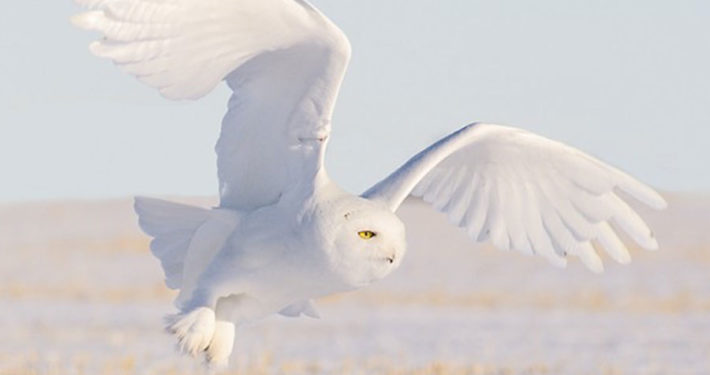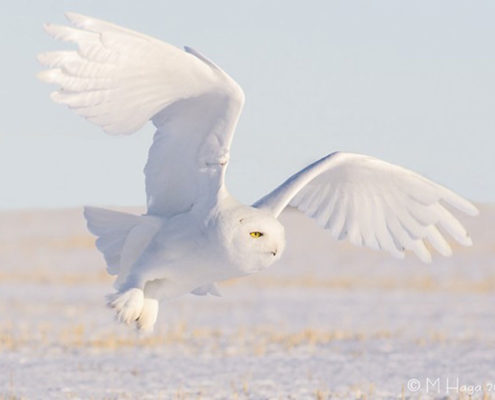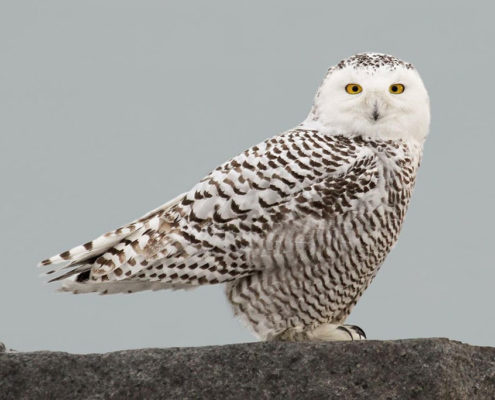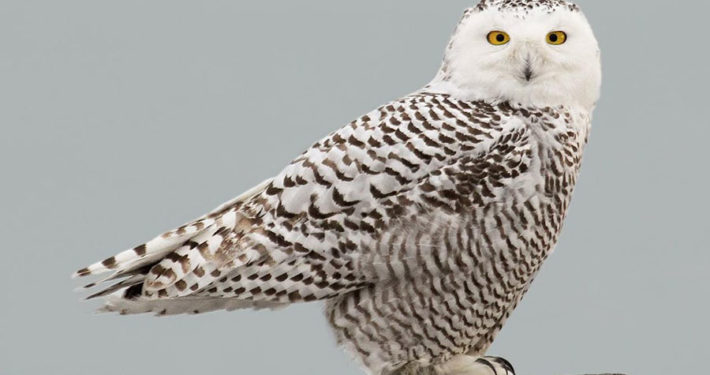Snowy Owl
Description
The male Snowy Owl is pure white, with the female accented by dark markings on its white feathers, so colored for camouflage during northern winters in the high Arctic tundra. Their heads are smoothly rounded and they have no ear tufts. The body of the Snowy Owl is bulky, with dense feathering on the legs, making the bird look wide at the base when sitting on the ground.
Its thick feathers, necessary for insulation from Arctic cold, result in making the Snowy Owl the heaviest bird in North America. These birds are powerful, with females out-sizing males, measuring 60-75 cm (22-26 in) and weighing 2-6.5 lbs, with males typically 55-64 cm (21-23 in) and weighing 1.5-5.5 lbs.
Snowy Owls are native to Arctic tundra, north of tree line. They spend summers far north of the Arctic Circle hunting small rodents called lemmings, ptarmigan, and other prey in 24-hour daylight. When the lemming population booms, they can raise double or triple the usual number of young. When Snowy Owls fly farther south to locations such as Massachusetts, they seek out areas that look similar to their Arctic territory: prairies, wide-open fields, beaches, lake edges. Amazingly, they stay in open areas at all times of day and night.
The reason for this is that Snowy Owls are diurnal and will, for example, hunt at all hours during the continuous daylight of an Arctic summer. For their nests, Snowy Owls choose raised sites, often located on the top of a mound in hilly locations, or on hummock in low-lying areas. The same site may be used by the Snowy Owl year after year.
Snowy Owls are silent other than sounding croaks or whistles during breeding. These almost magical creatures possess keen vision and extraordinary hearing to capture prey. Snowy Owls may sit still in one location for many hours, with the only movement being occasionally swiveling their head. Yet when they hunt, they are quick and strong, flying and running, pouncing and dive-bombing their prey.
In the Arctic, Snowy Owls may feed almost exclusively on lemmings when these are available. Otherwise, their prey includes a wide variety of mammals including rabbits, hares, voles, and ground squirrels, and in coastal areas, fish, carrion, ducks, geese, and even songbirds
Additional Info
*TWO VERY INTERESTING FACTS!*
FACT ONE:
Whereas while many Arctic animals who are white in the winter in order to blend with snow and ice and be less visible to predators and prey change in the summer to feathers or fur of brown, the Snowy Owl does not. It remains white on a year-round basis. The reason for this is because the short Arctic summer does not allow for the Snowy Owl to grow a new set of feathers (which usually takes 5 - 6 months).
FACT TWO:
Snowy owls build their own nests, one of the few species of owl that does so.
CONCERNS:
Snowy Owls nest in remote areas and cover large territories, thus their remote breeding grounds are generally free from direct human disturbance. Snowy Owl is a U.S.-Canada Stewardship species and is listed on the 2016 State of North America's Birds' Watch List, which includes bird species that are most at risk of extinction without significant conservation actions to reverse declines and reduce threats. Snowy Owls are protected from trapping and shooting.










